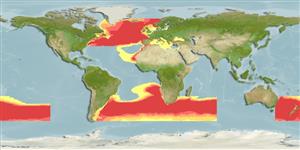Environment: milieu / climate zone / depth range / distribution range
Ecología
marino batipelágico; rango de profundidad 40 - 1050 m (Ref. 52180), usually 300 - 700 m (Ref. 52180). Deep-water; 68°N - 55°S, 180°W - 180°E
North Atlantic: Nova Scotia and Grand Banks (Canada) to Massachusetts, USA (Ref. 7251). Also known from the Northeast Atlantic and the Mediterranean Sea. Southeast Atlantic and Indian Ocean: South Africa and Australia (including New South Wales). Southwest Pacific: New Zealand. Southern Ocean. Antitropical.
Tamaño / Peso / Age
Maturity: Lm ? range ? - ? cm
Max length : 150 cm SL macho / no sexado; (Ref. 4542); common length : 60.0 cm TL macho / no sexado; (Ref. 3397)
Short description
Claves de identificación | Morfología | Morfometría
Espinas dorsales (total) : 5; Radios blandos dorsales (total) : 37 - 41; Espinas anales: 3; Radios blandos anales: 20 - 24. Dark brown to black, occasionally almost bluish; median and pelvic fins darker than body; young with 2-4 vertical bars (Ref. 4410). Snout is slightly longer than the eye diameter (Ref. 35388).
An oceanic, epipelagic or mesopelagic species (Ref. 6942). Juveniles occurring in surface waters (Ref. 4542) and associated with pelagic medusas and salps (Ref. 4410), adults found deeper (Ref. 4542). May form small schools. Appears to feed on whatever is available, small fish, squid, large pelagic crustaceans, and other plankton (Ref. 4542).
Life cycle and mating behavior
Madurez | Reproducción | Puesta | Huevos | Fecundidad | Larva
Haedrich, R.L., 1990. Centrolophidae. p. 1011-1013. In J.C. Quero, J.C. Hureau, C. Karrer, A. Post and L. Saldanha (eds.) Check-list of the fishes of the eastern tropical Atlantic (CLOFETA). JNICT, Lisbon; SEI, Paris; and UNESCO, Paris. Vol. 2. (Ref. 6942)
IUCN Red List Status (Ref. 130435: Version 2024-1)
Threat to humans
Harmless
Human uses
Pesquerías: de interés potencial; pesca deportiva: si
Herramientas
Special reports
Download XML
Fuentes de Internet
Estimates based on models
Preferred temperature (Ref.
123201): 2.7 - 11.9, mean 7 °C (based on 632 cells).
Phylogenetic diversity index (Ref.
82804): PD
50 = 1.0000 [Uniqueness, from 0.5 = low to 2.0 = high].
Bayesian length-weight: a=0.00661 (0.00334 - 0.01306), b=3.09 (2.91 - 3.27), in cm total length, based on LWR estimates for this species & (Sub)family-body (Ref.
93245).
Nivel trófico (Ref.
69278): 3.9 ±0.38 se; based on food items.
Resiliencia (Ref.
120179): Muy bajo, población duplicada en un tiempo mínimo superior a 14 años (Preliminary K or Fecundity.).
Fishing Vulnerability (Ref.
59153): Very high vulnerability (90 of 100).
Climate Vulnerability (Ref.
125649): Moderate vulnerability (38 of 100).
Nutrients (Ref.
124155): Calcium = 13.3 [4.9, 29.3] mg/100g; Iron = 0.277 [0.123, 0.772] mg/100g; Protein = 18.7 [16.7, 20.6] %; Omega3 = 0.164 [0.069, 0.380] g/100g; Selenium = 21.1 [7.6, 55.5] μg/100g; VitaminA = 20.5 [2.8, 160.8] μg/100g; Zinc = 0.376 [0.209, 0.737] mg/100g (wet weight);
